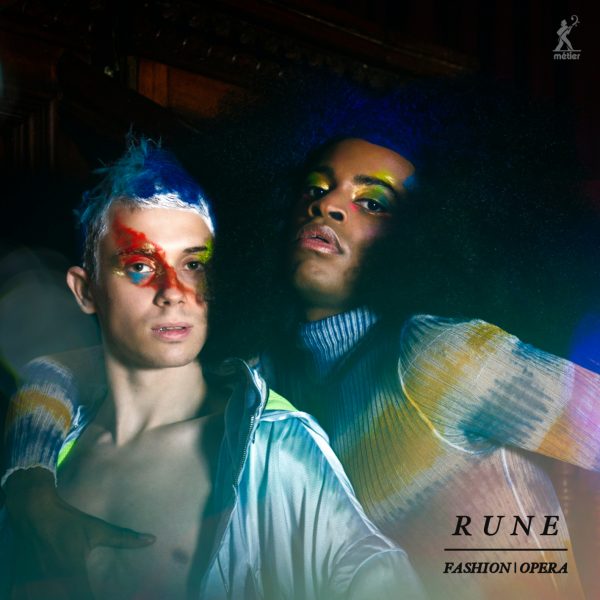Planet Hugill
On dazzling form, Alastair White’s new opera, recorded live, creates seductive, virtuoso textures from just two singers and three pianos.
Alastair White’s Fashion|Opera Rune debuted at the Round Chapel in Hackney as part of Tête-à-Tête: The Opera Festival and a live recording has appeared on Métier, with soprano Patricia Auchterlonie and mezzo-soprano Simone Ibbett-Browne and an ensemble of three pianos played by Ben Smith (music director), Joseph Havlat and Siwan Rhys.
Setting White’s own text, the opera appears at first sight to be a complex, cosmological, Science-Fiction fantasy. The libretto’s argument goes thus, ‘On a planet where history is forbidden, a young girl dares to tell her story. A voyage across galaxies and millennia, hers is a tale of the archipelagos of Khye-rell and their matterwork, through transdimensional canals and sea lanes to the RUNE of the universe’s origin. This song, her story – through the very act of being told – will have consequences beyond imagining‘
But a closer reading of the text brings us to a series of poetic meditations, the Sci-Fi details less important than the remarkable imagery. White’s operas have a boiled-down quality that is striking in the way he can distil complexities down to their essence. I have to confess that despite reading the libretto a few times, I haven’t the slightest idea about quite what is happening. The text is highly poetic both in its content and layout, as well as the use of multiple fonts, great care has been taken.
Instead of a series of dramatic scenes, White seems to be giving us an allusive meditation on the emotions behind the drama, leaving much to our own imaginations.
The two vocal lines, for Patricia Auchterlonie as Kes’Cha’Au and Simone Ibbett-Brown as Khye-Rell are complex and virtuoso. Both singers dazzle in the way they despatch White’s elaborate vocal lines. This is not bravura display for its own sake, but as an essential part of White’s musical language. There are moments of calm and contemplation, but emotional complexity is rarely far away. The writing has a luxuriance to it, a sense of White’s need to make notes proliferate to match the vivid poetic imagery of the texts.
Surrounding this are the imaginative textures of the writing for the three pianos. Not necessarily big and beefy, the music moves between tender and virtuosic, with textures sometimes deceiving so that you think other instruments are involved. I have no idea whether the instrumentation was originally conceived like this or whether we are hearing White’s response to the complexities of staging opera in these COVID times, but the results are vividly realised here.
To enter White’s world is to enter a parallel universe, but one where the usual Sci-Fi obsession with nitty-gritty and detail is avoided. Instead, we have a dazzling fantasy that explores alternative ideas and realities. A dull summary of the opera might dangerously veer towards adolescent fantasy, but you only have to listen to a few minutes of White’s music to realise that here is an artist securely in charge of his own destiny and his own musical style.
The recording has no sense of being live, or of the uncertainties of creation. All five performers are impressive in their grasp of the complexities of White’s language, and the way these complex lines are woven into a whole which transcends the virtuoso elements.
The whole is profoundly seductive, a sound world that dazzles and intrigues, telling a story that is just out of reach yet with a strong emotional pull.
@divineartrecordingsgroup
A First Inversion Company
Registered Office:
176-178 Pontefract Road, Cudworth, Barnsley S72 8BE
+44 1226 596703
Fort Worth, TX 76110
+1.682.233.4978










![Listen to the full suite of Marcel Dupré’s Variations Sur un Noël, Op. 20 from Alexander Ffinch’s #Expectations release today! listn.fm/expectations [in bio]](https://scontent-dfw5-1.cdninstagram.com/v/t51.71878-15/588904367_2327488161082898_8709236950834211856_n.jpg?stp=dst-jpg_e35_tt6&_nc_cat=105&ccb=7-5&_nc_sid=18de74&efg=eyJlZmdfdGFnIjoiQ0xJUFMuYmVzdF9pbWFnZV91cmxnZW4uQzIifQ%3D%3D&_nc_ohc=b5g9hiAMsPAQ7kNvwFAzaYv&_nc_oc=AdkB89uQb4caMJmfq6K5bEmB-ZcmPwU0IMowaL643vXP8r7ivqTlyPgpIp0DqJZYe8XX_RepHMv9w7JFCc0b6m3c&_nc_zt=23&_nc_ht=scontent-dfw5-1.cdninstagram.com&edm=ANo9K5cEAAAA&_nc_gid=cBLDPiUcLdl88q9tUlxhpg&oh=00_AfkRIYhz1RXYkMlxcLiF1YvZGlq5ubFZSd0BdXm9MPZcKQ&oe=695093AA)

![“the ‘Manteca’ Paraphrase – a rare foray into the two-piano medium but here played double-tracked – exudes a panache of which Dizzy Gillespie would surely have approved.… [a] recital well worth investigating.” —Gramophone Magazine with high praise for Ophelia Gordon's debut release, Kapustin: Between the Lines!](https://scontent-dfw5-3.cdninstagram.com/v/t51.82787-15/598796470_18303255136283342_540941604740887837_n.jpg?stp=dst-jpg_e35_tt6&_nc_cat=108&ccb=7-5&_nc_sid=18de74&efg=eyJlZmdfdGFnIjoiRkVFRC5iZXN0X2ltYWdlX3VybGdlbi5DMiJ9&_nc_ohc=qJeKeEK7ScQQ7kNvwGwvEbZ&_nc_oc=AdkYFWtyXUlUelg7YtcKtU7S8sszyleguqNZH5viU-CLTxBvG-tkI88Pz0udszHIEixenuVmJIW5vSilE3IGp8oa&_nc_zt=23&_nc_ht=scontent-dfw5-3.cdninstagram.com&edm=ANo9K5cEAAAA&_nc_gid=cBLDPiUcLdl88q9tUlxhpg&oh=00_AfmPNaAeziqCloyYcT3vNAcdAWv5FkUw8ovqQGVsMjvumQ&oe=69506E04)